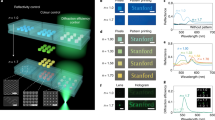Abstract
In recent years, a number of different technologies have been proposed for use in reflective displays1,2,3. One of the most appealing applications of a reflective display is electronic paper, which combines the desirable viewing characteristics of conventional printed paper with the ability to manipulate the displayed information electronically. Electronic paper based on the electrophoretic motion of particles inside small capsules has been demonstrated1 and commercialized; but the response speed of such a system is rather slow, limited by the velocity of the particles. Recently, we have demonstrated that electrowetting is an attractive technology for the rapid manipulation of liquids on a micrometre scale4. Here we show that electrowetting can also be used to form the basis of a reflective display that is significantly faster than electrophoretic displays, so that video content can be displayed. Our display principle utilizes the voltage-controlled movement of a coloured oil film adjacent to a white substrate. The reflectivity and contrast of our system approach those of paper. In addition, we demonstrate a colour concept, which is intrinsically four times brighter than reflective liquid-crystal displays5 and twice as bright as other emerging technologies1,2,3. The principle of microfluidic motion at low voltages is applicable in a wide range of electro-optic devices.
This is a preview of subscription content, access via your institution
Access options
Subscribe to this journal
Receive 51 print issues and online access
$199.00 per year
only $3.90 per issue
Buy this article
- Purchase on Springer Link
- Instant access to full article PDF
Prices may be subject to local taxes which are calculated during checkout




Similar content being viewed by others
References
Comiskey, B., Albert, J. D., Yoshizawa, H. & Jacobson, J. An electrophoretic ink for all-printed reflective electronic displays. Nature 394, 253–255 (1998)
Sheridon, N. K. et al. in Proc. IDRC97 (ed. Morreale, J.) L82–L85 (Society for Information Display, Toronto, 1997)
Podojil, G. M. et al. in SID98 Digest (ed. Morreale, J.) 51 (Society for Information Display, Anaheim, CA, 1998)
Prins, M. W. J., Welters, W. J. J. & Weekamp, J. W. Fluid control in multichannel structures by electrocapillary pressure. Science 291, 277–279 (2001)
Grupp, J. in Eurodisplay Digest 2002 35–38 (Le Club Visu, SID-France, Nice, 2002)
Welters, W. J. J. & Fokkink, L. G. J. Fast electrically switchable capillary effects. Langmuir 14, 1535–1538 (1998)
Quilliet, C. & Berge, B. Electrowetting: A recent outbreak. Curr. Opin. Colloid Interface Sci. 6, 34–39 (2001)
Berge, B. & Peseux, J. Variable focus lens controlled by an external voltage: An application of electrowetting. Eur. Phys. J. E 3, 159–163 (2000)
Pollack, M. G., Fair, R. B. & Shenderov, A. Electrowetting-based actuation of liquid microdroplets for microfluidic applications. Appl. Phys. Lett. 77, 1725–1726 (2000)
Seyrat, E. & Hayes, R. A. Amorphous fluoropolymers as insulators for reversible low-voltage electrowetting. J. Appl. Phys. 90, 1383–1386 (2001)
Moon, H., Sung, K. C., Garrell, R. L. & Kim, C. J. Low voltage electrowetting-on-dielectric. J. Appl. Phys. 92, 4080–4087 (2002)
Beni, G. & Hackwood, S. Electrowetting displays. Appl. Phys. Lett. 38, 207–209 (1981)
Ritter, J. in IDW01 Digest 343 (Society for Information Display, Nagoya, 2001)
Acknowledgements
We acknowledge the infrastructural support provided by the Devices, Technology & Services Department, our project colleagues and our team of students (M. Joulaud, J. Guiberteau, R. Massard, E. Morks, A.-S. Dupont, K. Girard, C. Maufrais and P. Jaulneau).
Author information
Authors and Affiliations
Corresponding authors
Ethics declarations
Competing interests
The authors declare that they have no competing financial interests.
Supplementary information
41586_2003_BFnature01988_MOESM1_ESM.zip
Supplementary Information: This Zip file contains 6 movie files which can be downloaded and a word document giving a brief description of each movie. (ZIP 5198 kb)
Rights and permissions
About this article
Cite this article
Hayes, R., Feenstra, B. Video-speed electronic paper based on electrowetting. Nature 425, 383–385 (2003). https://doi.org/10.1038/nature01988
Received:
Accepted:
Issue Date:
DOI: https://doi.org/10.1038/nature01988
Comments
By submitting a comment you agree to abide by our Terms and Community Guidelines. If you find something abusive or that does not comply with our terms or guidelines please flag it as inappropriate.



